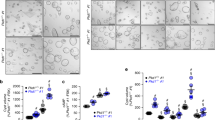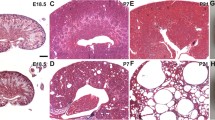Abstract
BALB/c mice homozygous for the bpk gene exhibit a form of autosomal recessive (AR) polycystic kidney disease (PKD) with massive collecting duct cysts, common bile duct dilation and chaotic intrahepatic bile ducts/portal triads. The combined renal and biliary pathology mimics much of the pathology seen in human ARPKD. Murine models of ARPKD generally have a reduced renal expression of epidermal growth factor (EGF) and an increased expression of EGF receptors (EGF-R). However, the role that EGF and EGF-R play in the progression of PKD has been unclear. Evidence from various model systems/ages of treatment produces conflicting results. Treating neonatal C57BL/6J-cpk mice with EGF ameliorates the renal pathology and dysfunction while treating 2- and 3-week-old bpk mice with an EGF-receptor tyrosine kinase inhibitor also ameliorates ARPKD. Therefore, to determine whether neonatal EGF treatment would accelerate or inhibit the progression of the PKD in bpk mice, we administered exogenous EGF (1 µg/g body weight subcutaneously) daily from postnatal days 3–9 (a critical period for tubule maturation). Neonatal EGF treatment but not sham treatment retarded the development of azotemia and common bile duct dilation and the chaotic hepatic triad changes in cystic mice. However, EGF treatment neither reduced the severity of the renal cystic pathology nor reduced the degree of cystic enlargement of the kidneys. Cystic mice treated past 9 days of age died prior to their scheduled termination at 21 days of age. The role of EGF in the progression of polycystic kidney disease in bpk mice is relatively complicated, with neonatal treatment being associated with some amelioration of the renal dysfunction and extrarenal pathology without an effect on the renal pathology. Continuation of treatment beyond 9 days increased morbidity. Therefore, in discussing the role of EGF or EGF receptor in mediating the pathophysiology of PKD, the stage of development may be an important consideration.
Similar content being viewed by others
Author information
Authors and Affiliations
Additional information
Received: 8 March 2000 / Revised: 29 August 2000 / Accepted: 30 August 2000
Rights and permissions
About this article
Cite this article
Nakanishi, K., Gattone II, V., Sweeney, W. et al. Renal dysfunction but not cystic change is ameliorated by neonatal epidermal growth factor in bpk mice. Pediatr Nephrol 16, 45–50 (2001). https://doi.org/10.1007/s004670000495
Issue Date:
DOI: https://doi.org/10.1007/s004670000495




